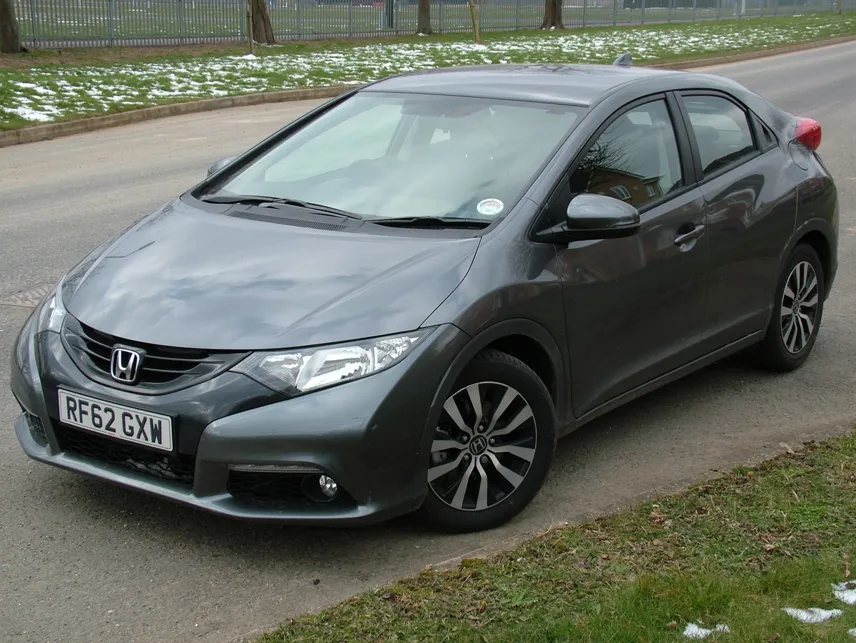Review
Most people agree that the Honda Civic is great to look at, but when you are inside looking out opinions begin to differ.
Rear visibility is hampered for several reasons. The low sloping rear end means the vertical opening isn’t that large in the first place, but what space there is has been taken up with a very substantial light cluster and spoiler combination.
In terms of its design to help fuel economy and smooth airflow, then it does its job extremely effectively. As I mentioned in my last test, fuel economy is consistently over 60mpg in real-world tests.
I even tried to drive as uneconomically as possible to see how far the figure might dip and economy didn’t fall below 58mpg.
However, for some reviewers, there is a fair amount of looking back in anger, or at least angst, as there isn’t a clear view of following traffic or when reversing.
There is an excellent rear view camera in our ES-T option, which helps, although it would be nice if rear parking sensors were standard, rather than just an option.
I can see why it can be a constant niggle if you aren’t comfortable with it, but over the past six months I have just adapted to it and barely notice the ever present shadow in my rear view mirror over the past 7,000 miles.
While the view of traffic might be an issue, the expected costs for fleets are much clearer thanks to an excellent feature on the Fleet News website.
The Car Running Costs service allows you to compare up to five models back-to-back in just a couple of clicks.
It is eye-opening to see the wealth of choice of vehicles that emit less than 100g/km, but for reference, I chose models from Audi, Vauxhall and Kia, representing Premium, Volume and New Generation segments to compare over four years/80,000 miles.
This reflects Sewells research showing increasing movement between segments by company car drivers.
The Vauxhall Astra ecoFLEX 1.7 CDTi emits just 99g/km and has a claimed 76.3mpg. Despite its lower P11D price (£19,950 versus around £22,000 for the Civic), it has higher depreciation, SMR and fuel costs, meaning wholelife costs of 31.7ppm against the Honda’s 30.51ppm.
The Audi A3 Sportback SE has a cheaper P11D price at just over £21,000 (although it has a less powerful engine and I haven’t benchmarked equipment levels) and its lower depreciation makes up for higher SMR and fuel use compared to the Honda, to give it a better wholelife cost of 29.82ppm.
Finally, the Kia 1.6 CRDi EcoDynamics 2 matches the Honda for power, but at a much lower P11D price of around £18,000.
It is worth nearly £2,000 less than the Honda at defleet time, but still manages to depreciate less, which offsets higher SMR and fuel costs, so it costs less at 29.4ppm.
Clearly each fleet will have its own supply and pricing arrangements, but the Fleet News service provides a very useful and quick benchmark for comparing a basket of potential vehicles for a choice list.
Specs
| Manufacturer | Honda |
| Model | Civic |
| Specification | |
| Model Year | 0.00 |
| Annual VED (Road tax) | £0 |
| BIK List Price | £21,720 |
| CO2 | 94g/km |
| BIK Percentage | 13% |
| Insurance Group | N/A |
| CC | N/A |
| Fuel Type | Diesel |
| Vehicle Type | |
| Luggage capacity (Seats up) | N/A |
Running Costs
| P11D | £21,720 |
| Cost per mile | 33.22ppm |
| Residual value | £8,125 |
| Insurance group | N/A |
| Fuel Type | Diesel |
| Cost per mile | 0.00ppm |
| Fuel | 0.00ppm |
| Depreciation | 0.00ppm |
| Service maintenance and repair | 0.00ppm |
Info at a glance
-
P11D Price
£21,720
-
MPG
78.5 -
CO2 Emissions
94g/km -
BIK %
13% -
Running cost
3 Year 60k : 33.22 4 Year 80k : £6,275 -
Fuel Type
Diesel















